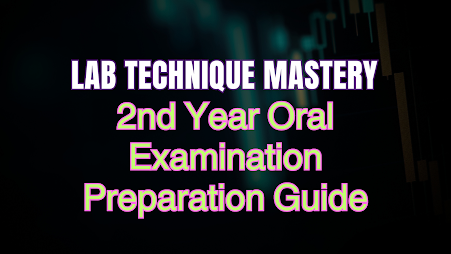Lab Techniques Viva: A Quick Guide to Ace Your Examination
THE STATE MEDICAL FACULTY OF BANGLADESH
2nd Year Final Examination of Diploma in Medical Technology Course, January-2023
Group: Laboratory Medicine
Subject: Laboratory Technique (Paper-I)
For viva:
Q-01
(a) Indications of blood transfusion include anemia, surgery, trauma, and certain medical conditions. Diseases transmitted by blood transfusion can include HIV, hepatitis B and C.
(b) Medical records are comprehensive documents containing a patient's health information. Importance of record keeping includes continuity of care, legal protection, and research.
(c) A store is a facility for storing items. Store management involves organizing, controlling, and overseeing the storage and distribution of goods.
(d) The professional code of conduct for a laboratory technologist includes maintaining confidentiality, accuracy in reporting, and ethical behavior.
(e) Cross infection is the transfer of infectious agents between patients. Preventing laboratory cross infection involves strict adherence to hygiene protocols, proper disposal of materials, and regular equipment sterilization.
Q-02
(a) Solutions are homogeneous mixtures. To prepare 500ml of 10% NaCl solution, dissolve 50g of NaCl in water.
(b) Waste disposal in a medical laboratory involves proper segregation, labeling, and disposal methods for various types of waste.
(c) Anticoagulants include EDTA, heparin, and citrate. They are used to prevent blood clotting in laboratory samples.
(d) Microscopes are classified into light and electron microscopes. Low, high, and oil immersion objectives have different magnifications. Low provides a broad view, high offers more detail, and oil immersion provides the highest magnification.
(e) Accepting and preparing a patient involves proper identification, explanation of procedures, and ensuring a comfortable environment.
Q-03
(a) Safe transportation of specimens requires proper packaging, labeling, and adherence to transportation regulations.
(b) Common laboratory hazards include chemicals, biological materials, and physical hazards. Prevention involves proper training, use of protective equipment, and adherence to safety protocols.
(c) Chemicals are substances with a defined composition, while reagents are substances used in chemical reactions.
(d) Collection of blood from fingertips involves cleansing the site, puncturing with a lancet, and collecting the blood in a capillary tube or microcontainer.
(e) Safe transport of specimens involves secure packaging, correct labeling, and adherence to transportation guidelines.
Q-04
(a) Common tests in upazilla health complexes include basic blood tests, urinalysis, and infectious disease screenings.
(b) Important instruments in district laboratories may include centrifuges, microscopes, and automated analyzers.
(c) SI unit (International System of Units) is the standard system of measurement. Quality control involves maintaining consistent and accurate results in laboratory testing.
(d) Catheterization involves the introduction of a catheter into a body cavity. Principles, types, and indications vary based on the specific procedure.
(e) Short notes on:
- Incineration: A method of waste disposal involving high-temperature burning.
- Haemocytometer: A device for blood cell counting.
- Reagent strip: A strip containing chemical reagents for detecting substances in a sample.
- PBF (Peripheral Blood Film): A blood smear used for microscopic examination.
- Microtome: Instrument for cutting thin sections of tissues for microscopy.










No comments